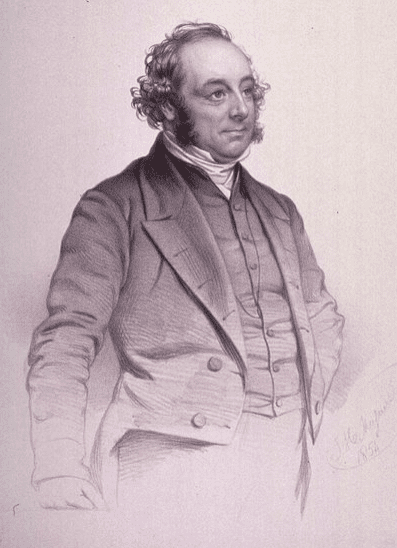Arpan K. Banerjee
Solihull, United Kingdom
 |
| Drawing of William Sands Cox by T H Mcguire. 1854. Public domain. Via Wikimedia |
In the early nineteenth century Birmingham was the second largest city in England. It was an industrial powerhouse, known as the city of a thousand trades, but it did not have its own medical school. Those wishing to become doctors had to train in London.
William Sands Cox was born in Birmingham in 1802 and was educated in the city at the King Edward’s School. In 1820 he began his medical career at the Birmingham General Hospital as an apprentice to his father, Edward T. Cox, a surgeon at the hospital.1 He continued his training in London at Guy’s and St. Thomas’ Hospitals, learning from the famous surgeon Sir Astley Cooper (who described Cooper’s ligaments in the breast, among his many contributions to anatomy and surgery). Sir Astley Cooper had a flourishing surgical practice and later provided testimonials for Sands Cox’s surgical job applications. In 1823 Sands Cox graduated as licentiate of the Society of Apothecaries and in 1824 became member of the Royal College of Surgeons. In 1843 he was elected founding fellow. He left for Paris for a year to continue his training with celebrities such as Dupuytren (of contracture fame) and Laennec (discoverer of the stethoscope).
Returning to Birmingham, he set up a surgical practice with his father. From 1825 he was teaching anatomy at his house in Temple Row2 but soon realized that larger premises were required and that the city needed a formal medical school. A blue plaque in Temple Row commemorates the site where the first medical instruction was given in Birmingham. Today the site is occupied by a major department store. As a medical school needed an attached teaching hospital, Sands Cox helped to found the new Queen’s Hospital. This opened in 1841 and was named after Queen Victoria, who had given her blessing for the project. He was to be appointed surgeon to this hospital.3 Queen’s Hospital later became the Birmingham Accident Hospital in 1941; it was eventually closed in 1993.
In 1828 a medical school was founded and in 1843 it became by royal charter the Queen’s College, housed in a new Gothic building opposite the town hall. The new medical school had a lecture theatre, laboratories for physiology and anatomy dissection, as well as accommodation for seventy students. Its success was made possible by the philanthropy of Samuel Warneford (1763-1855), an eccentric zealous cleric who was also governor of the famous Radcliffe Infirmary in Oxford and a benefactor to King’s College London. Warneford was a man of strong religious beliefs and made sure the medical school he supported in Birmingham was an Anglican establishment. Instruction was provided not only in medicine and science but also in theology. Sands Cox wanted the college to also teach science, engineering, and the arts, and medical degrees would be awarded by the University of London. Sadly, the college was to split up because of internal wrangling. A breakaway Mason Science College was formed in 1875, helped by the philanthropy of the self-taught industrialist and pen manufacturer Sir Josiah Mason. The medical and science departments of Queen’s College were moved to the Mason Science College, which in 1900 was incorporated into the new University of Birmingham.
In 1831 Sands Cox published an illustrated 342-page book for his students based on his lectures in anatomy and surgery, A Synopsis of the Bones, Ligaments, Muscles, Blood vessels, and Nerves of the Human Body.4 He became a fellow of the Royal Society in 1836, a rare honor for a surgeon.5 For many years he was the editor of the annual reports of Queen’s Hospital, where he was senior surgeon.6 In 1858 he became principal of Queen’s College. In 1863, following disputes with management, he retired from his surgical roles at the hospital. In retirement he wrote about the history of the medical school he had helped found. He married Isabella Lichfield in 1866 and died on 23 December 1875.
In 1983, the Birmingham Medical School set up the Sands Cox Society, which in 2014 became the Sands Cox Charity. Its purpose was to support the training of medical students and communication among the alumni of the medical and dental school.
Reference
- Obituary William Sands Cox . Brit Med J 1876 1:29
- Roberts KD William Sands Cox. An Historical Vignette 2017 https://www.sandscoxcharity.uk/an-historical-vignette
- William Sands Cox. Archive of Birmingham Medical School
- William Sands Cox. A Synopsis of the Bones, Ligaments, Muscles, Blood-Vessels, and Nerves of the Human Body, 1831, Birmingham
- William Sands Cox. Lives of Fellows RCS 19/8/2011
- William Sands Cox Archives Library of Birmingham, UK
ARPAN K. BANERJEE, MBBS (LOND), FRCP, FRCR, FBIR, qualified in medicine at St. Thomas’s Hospital Medical School, London. He was a consultant radiologist in Birmingham from 1995-2019. He served on the scientific committee of the Royal College of Radiologists 2012-2016. He was Chairman of the British Society for the History of Radiology from 2012-2017. He is Treasurer of ISHRAD and adviser to radiopaedia. He is the author/co-author of numerous papers and articles on a variety of clinical medical, radiological, and medical historical topics and seven books including Classic Papers in Modern Diagnostic Radiology 2005 and “The History of Radiology” OUP 2013.

Leave a Reply